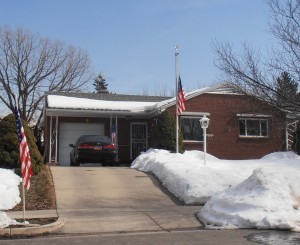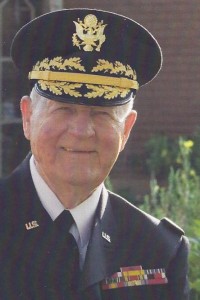The Spontaneous Display of the U.S. Flag

The home of a neighbor, Sterling R. Ryser, with the flag displayed at half-staff
A funeral took place in a neighborhood chapel, which in my area—with its older residents—is not unusual. However, as I drove down the street I saw U.S. flags lining the way to the church where I found the Stars and Stripes flying at half-staff. Having checked Colonial Flag’s The Flag App, I knew that neither the President nor the State’s Governor had issued a Half-Staff Proclamation for the date. Since I worship in another neighborhood chapel, I was not even sure who had died, and so I called my son who is a member of that particular congregation.
I learned that Sterling Ryser, a neighbor I have met only briefly, had died. The posted flags leading from his home to the church, together with flags flown at half-staff at the Ryser home and at the church, were displayed in a spontaneous act by family, friends and neighbors.
Some might think this inappropriate, citing rules stated in the U.S. Flag Code where only the President and Governors are given authority to order that flags be displayed at half-staff. Actually, the U.S. Flag Code describes a list of officials who warrant automatic half-staff display of the flag. A few of those listed with the number of days when the flag automatically flies at half-staff include: thirty days for a President or Former President; ten days for the Vice President or Speaker of the House; from death until burial for a former Vice President or a State’s Governor; and on the day of death and the following day for a member of Congress. Somehow this all seems too formal and too bureaucratic—certainly not spontaneous mourning.
Originally, the Flag Code only prescribed that the flag be flown at half-staff on Memorial Day, and then only until noon. Now an ever growing list of holidays has been added. While intended to honor certain events, these additions do not follow the original meaning of displaying a flag at half-staff. From its earliest beginning at sea, the half-mast display of a ship’s ensign signified bereavement and mourning.
A visitor to a Healing Field® flag display event told a newspaper reporter, “No person can receive a greater honor than to have the U.S. flag flown to honor him.” Traditionally, the flag flown at half-staff is not done to honor, but to show mourning.
Sterling Ryser was a loved father and grandfather; an appreciated and respected neighbor; an active lay leader of his church serving neighbors and in foreign lands—and it would seem appropriate that these qualities justified the spontaneous display of flag lined streets to honor him and flags at half-staff to show sincere mourning at his death. Nevertheless, there is more to the story.
This neighbor was also known as Major General Sterling R. Ryser, U.S. Army Retired. He first served his country during World War II when he achieved the rank of Lieutenant Colonel. He was called again to active duty during the Korean War and continued to serve in the U.S. Army Reserves during the Cold War. Retiring as a Major General after thirty-five years, he continued to serve his country as a civilian working with the Central Intelligence Agency.

Major General Sterling R. Ryser
At the funeral, his son, Ralph Ryser, noted that during his travels Sterling Ryser always carried a U.S. flag with him. He carried a flag with him as an L.D.S. missionary in southern Germany and Switzerland during the late 1930s when he saw firsthand the Nazis rise to power. He carried a flag with him when deployed in war and later when stationed abroad. In retirement he flew the U.S. flag on a flagpole at his home. He honored the flag of the United States with its display and with his actions. It was, therefore, especially appropriate that the flag should, in return, honor him. Had Utah’s Governor been petitioned to issue a Half-Staff Proclamation upon the death of Major General Ryser, it is likely he would have complied. Nevertheless, perhaps it is better and more meaningful that the flag display was carried out spontaneously by friends and neighbors to honor and to mourn a man who earned it. At my house the flag flew at half-staff.
